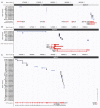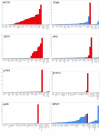Combined subtractive cDNA cloning and array CGH: an efficient approach for identification of overexpressed genes in DNA amplicons
- PMID: 15018647
- PMCID: PMC365025
- DOI: 10.1186/1471-2164-5-11
Combined subtractive cDNA cloning and array CGH: an efficient approach for identification of overexpressed genes in DNA amplicons
Abstract
Background: Activation of proto-oncogenes by DNA amplification is an important mechanism in the development and maintenance of cancer cells. Until recently, identification of the targeted genes relied on labour intensive and time consuming positional cloning methods. In this study, we outline a straightforward and efficient strategy for fast and comprehensive cloning of amplified and overexpressed genes.
Results: As a proof of principle, we analyzed neuroblastoma cell line IMR-32, with at least two amplification sites along the short arm of chromosome 2. In a first step, overexpressed cDNA clones were isolated using a PCR based subtractive cloning method. Subsequent deposition of these clones on a custom microarray and hybridization with IMR-32 DNA, resulted in the identification of clones that were overexpressed due to gene amplification. Using this approach, amplification of all previously reported amplified genes in this cell line was detected. Furthermore, four additional clones were found to be amplified, including the TEM8 gene on 2p13.3, two anonymous transcripts, and a fusion transcript, resulting from 2p13.3 and 2p24.3 fused sequences.
Conclusions: The combinatorial strategy of subtractive cDNA cloning and array CGH analysis allows comprehensive amplicon dissection, which opens perspectives for improved identification of hitherto unknown targeted oncogenes in cancer cells.
Figures




Similar articles
-
Identification of amplified and expressed genes in breast cancer by comparative hybridization onto microarrays of randomly selected cDNA clones.Genes Chromosomes Cancer. 2002 May;34(1):104-14. doi: 10.1002/gcc.10039. Genes Chromosomes Cancer. 2002. PMID: 11921288
-
Characterization of a complex genomic alteration on chromosome 2p that leads to four alternatively spliced fusion transcripts in the neuroblastoma cell lines IMR-5, IMR-5/75 and IMR-32.Gene. 2005 Dec 19;363:41-50. doi: 10.1016/j.gene.2005.07.038. Epub 2005 Oct 10. Gene. 2005. PMID: 16216448
-
Characterization of amplicons in neuroblastoma: high-resolution mapping using DNA microarrays, relationship with outcome, and identification of overexpressed genes.Genes Chromosomes Cancer. 2008 Oct;47(10):819-34. doi: 10.1002/gcc.20583. Genes Chromosomes Cancer. 2008. PMID: 18553563
-
A decade of differential display.Biotechniques. 2002 Aug;33(2):338-44, 346. doi: 10.2144/02332rv01. Biotechniques. 2002. PMID: 12188186 Review.
-
Subtractive cloning: new genes for studying inflammatory disorders.Ann Periodontol. 2002 Dec;7(1):17-28. doi: 10.1902/annals.2002.7.1.17. Ann Periodontol. 2002. PMID: 16013213 Review.
Cited by
-
cDNA array-CGH profiling identifies genomic alterations specific to stage and MYCN-amplification in neuroblastoma.BMC Genomics. 2004 Sep 20;5:70. doi: 10.1186/1471-2164-5-70. BMC Genomics. 2004. PMID: 15380028 Free PMC article.
-
Broad expression analysis of human ANTXR1/TEM8 transcripts reveals differential expression and novel splizce variants.PLoS One. 2012;7(8):e43174. doi: 10.1371/journal.pone.0043174. Epub 2012 Aug 17. PLoS One. 2012. PMID: 22912819 Free PMC article.
-
Genes proximal and distal to MYCN are highly expressed in human neuroblastoma as visualized by comparative expressed sequence hybridization.Am J Pathol. 2008 Jan;172(1):203-14. doi: 10.2353/ajpath.2008.061263. Epub 2007 Dec 28. Am J Pathol. 2008. PMID: 18165268 Free PMC article.
-
High-resolution array copy number analyses for detection of deletion, gain, amplification and copy-neutral LOH in primary neuroblastoma tumors: four cases of homozygous deletions of the CDKN2A gene.BMC Genomics. 2008 Jul 29;9:353. doi: 10.1186/1471-2164-9-353. BMC Genomics. 2008. PMID: 18664255 Free PMC article.
-
Array-based gene expression, CGH and tissue data defines a 12q24 gain in neuroblastic tumors with prognostic implication.BMC Cancer. 2010 May 5;10:181. doi: 10.1186/1471-2407-10-181. BMC Cancer. 2010. PMID: 20444257 Free PMC article.
References
-
- Kallioniemi A, Kallioniemi OP, Sudar D, Rutovitz D, Gray JW, Waldman F, Pinkel D. Comparative genomic hybridization for molecular cytogenetic analysis of solid tumors. Science. 1992;258:818–821. - PubMed
-
- Knuutila S, Aalto Y, Autio K, Bjorkqvist AM, El-Rifai W, Hemmer S, Huhta T, Kettunen E, Kiuru-Kuhlefelt S, Larramendy ML, Lushnikova T, Monni O, Pere H, Tapper J, Tarkkanen M, Varis A, Wasenius VM, Wolf M, Zhu Y. DNA copy number losses in human neoplasms. Am J Pathol. 1999;155:683–694. - PMC - PubMed
Publication types
MeSH terms
Substances
LinkOut - more resources
Full Text Sources
Research Materials
Miscellaneous

